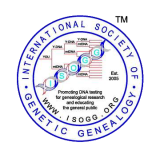I've re-examined my matches since I learned that the average male recombination rate is something like 2/3 of the rate for women, and I found something that I think is a bit unusual. Do you think so?
I have a female 4th cousin who matches my brother with a largest segment of 16 cM yet doesn't match me at all. We both descend from the most recent common ancestors through our respective direct male lines.
Doing a back-of-the-envelope calc reconciled to the published stats from FTDNA, given the gender differential in recombination, I would have thought we'd be a nearly 100% lock for a match.
Is this weird? How weird? A little? A lot?
I have a female 4th cousin who matches my brother with a largest segment of 16 cM yet doesn't match me at all. We both descend from the most recent common ancestors through our respective direct male lines.
Doing a back-of-the-envelope calc reconciled to the published stats from FTDNA, given the gender differential in recombination, I would have thought we'd be a nearly 100% lock for a match.
Is this weird? How weird? A little? A lot?


Comment